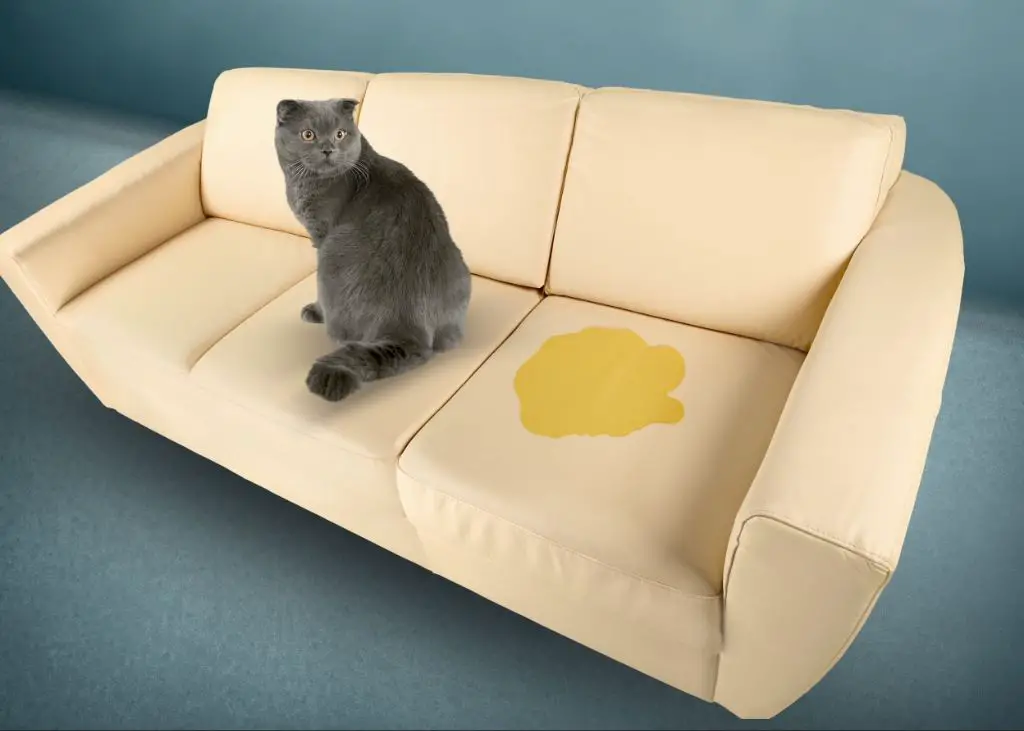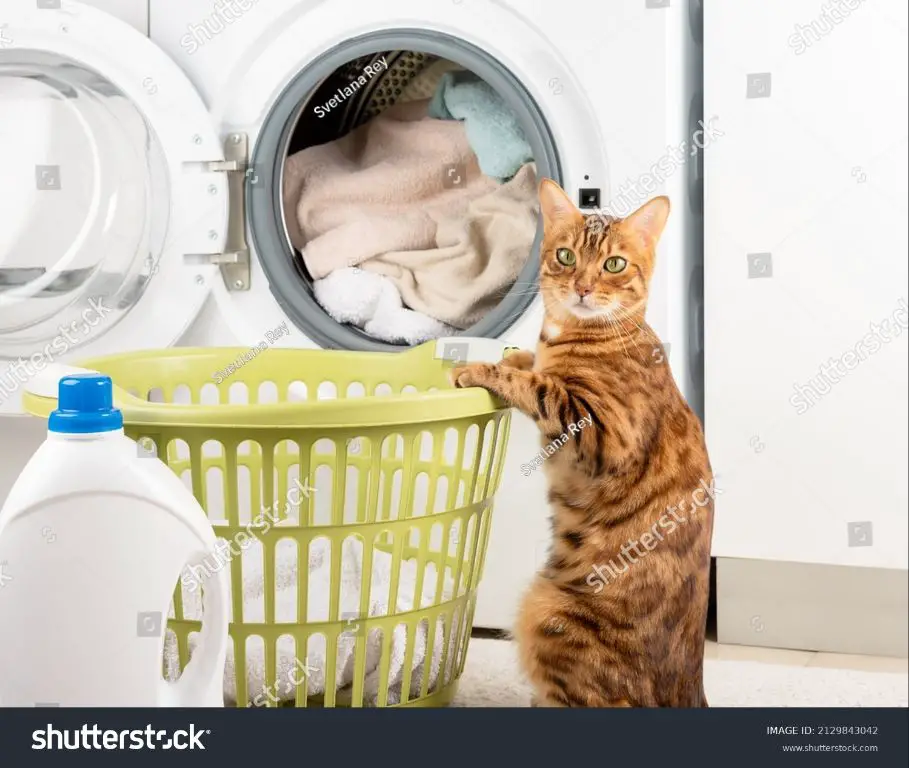Cat urine stains on clothes can be a frustrating problem for cat owners. When a cat has accidents outside their litter box, their urine can leave yellow, brown, or reddish stains and a pungent ammonia odor on fabrics. For people who own cats, it’s important to understand why cat urine stains form and how to effectively remove cat pee smells and stains from clothes.
Cat urine contains compounds like urea and ammonia that can bond tightly to the fibers in fabric. This makes the stains and odors difficult to eliminate completely. But with the right cleaning methods, most cat urine stains can be removed from washable clothes and other fabric items. Taking preventative measures like using repellents and addressing litter box issues can also help avoid cat urine stains in the first place.
This guide covers everything cat owners need to know about dealing with cat pee stains and odors. It provides tips for stain removal, odor elimination, preventing future accidents, and knowing when to call in professional help. With the proper techniques, cat urine stains don’t have to be a permanent headache.
Reasons Why Cats Urinate Outside the Litter Box

There are several common reasons why cats may urinate outside of their litter box, including medical conditions, stress/anxiety, marking territory, and issues with the litter box itself.
Certain medical conditions like urinary tract infections, kidney disease, or diabetes can cause increased urination or pain while urinating, leading a cat to urinate outside the box [1]. Cystitis, inflammation of the bladder, is another medical cause.
Stress, anxiety, or changes in a cat’s environment can also trigger inappropriate urination. Cats are sensitive creatures and may begin peeing outside the litter box in response to things like new people, pets, or routines in the household [2].
Some cats urinate outside the litter box as a way of marking territory. Intact male cats in particular may spray urine to mark areas and objects with their scent. This territorial marking is especially common with indoor cats.
Finally, issues with the litter box itself like an unclean box, unsuitable litter, or inconvenient location can lead cats to seek out alternatives for urinating. Cats prefer litter boxes that are scooped daily and filled with an unscented clumping litter.
Cat Urine Composition and Staining
Cat urine contains a high concentration of urea, which breaks down into ammonia. This ammonia binds strongly to fabrics through a process called ammoniacal decomposition, leading to stubborn yellowish stains (Catcentric.org). The ammonia smell from cat urine can also persist in fabrics even after cleaning. According to The Spruce Pets, “The uric acid in cat urine bonds with the proteins in fabrics, making stains more difficult to remove” (Source). So the chemical composition of cat urine with urea and uric acid makes it prone to staining and retaining odors in fabric.
Fabric Types and Stain Severity
The type of fabric and its porosity play a big role in how severely cat urine can stain clothing. Natural fabrics like cotton, wool, silk and linen are more prone to staining than synthetic fabrics like polyester, nylon and acrylic. This is because natural fibers are more porous and absorbent, allowing the urine to seep deep into the fibers. Synthetic fabrics tend to have a tighter weave and repel liquid better.
According to cleaning experts at Planet Urine, porous natural fabrics like cotton and wool can trap urine odors and stains very stubbornly, while smoother synthetics like polyester may only suffer surface staining. However, urine can still leave permanent stains on synthetics if left to set.
Problematic fabrics for cat urine stains include:
- Cotton – Highly absorbent and stains set in deeply
- Wool – Also highly porous and absorbent, odors cling to wool
- Silk – Delicate and stain prone, watermarks easily
- Linen – Very absorbent flax fiber holds stains stubbornly
- Rayon and viscose – Also made from plant fibers, prone to setting in stains
While synthetic fabrics resist staining better, urine can still bond to synthetics like nylon and acrylic if left unattended. So it’s important to act quickly when cleaning all fabric types.
Cleaning Cat Urine from Clothes
When cat urine gets on clothing, it’s important to act quickly to clean it before the urine dries and sets into the fabric. The first step is to blot up as much of the urine as possible with a paper towel or cloth. Don’t rub it in, as that will push the urine further into the fibers. Next, rinse the clothing under running water or soak it in cold water for 10-15 minutes. This will help dilute the urine and make it easier to remove.
After soaking, wash the clothing in your regular laundry detergent and the warmest water recommended for the fabric. The heat from the water will help release the urine from the fibers. You may need to wash the clothing two or three times to fully remove the urine smell. Avoid using any fabric softener or dryer sheets when washing urine-soiled clothing, as it can seal in the odor.

If the urine stain and smell still persist after washing, use a pet stain remover designed specifically for cat urine, such as Nature’s Miracle or Simple Green Pet Stain & Odor Remover. These products contain enzymes that help break down the urine compounds. Spray or soak the clothing with the pet enzymatic cleaner according to package directions before washing again.
With quick action and the right cleaning solutions, you can get fresh smelling clothing again after a cat urine accident.
Home Remedies for Stain Removal
There are several effective home remedies for removing cat urine stains and odors from fabrics and carpet. Common household products like vinegar, baking soda, and hydrogen peroxide can help tackle stubborn stains and smells.
Vinegar is highly acidic, which helps break down the uric acid crystals in cat urine. Mix equal parts white vinegar and warm water in a spray bottle. Lightly spray the vinegar solution onto the stained area and let it sit for 5-10 minutes before blotting and rinsing with cool water. The vinegar smell will dissipate as it dries.[1]
Baking soda acts as a natural deodorizer and odor absorber. Sprinkle baking soda liberally over the stain and let sit for 15-20 minutes before vacuuming up. The baking soda will help soak up any remaining moisture and urine salts.[2]
Hydrogen peroxide is a mild bleaching agent that helps remove discoloration and deodorize. Mix 1 part hydrogen peroxide with 2 parts water and spray or dab onto the stain. Let sit for 10 minutes before blotting and rinsing with cool water.
Enzyme cleaners work by breaking down the compounds in urine that cause stains and odors. Look for enzymatic cleaners specifically formulated for pets. Follow product instructions carefully.
Avoid using bleach or ammonia-based cleaners as they can set stains and make odors worse.
Preventing Cat Urine Stains
There are several steps you can take to prevent your cat from urinating outside the litter box and on your clothes:
Get your cat spayed or neutered. Unaltered cats are more likely to spray and mark territory. Spaying or neutering your cat reduces these behaviors.
Provide enough litter boxes. The general rule is one litter box per cat, plus an extra. Having multiple options prevents issues with a cat not liking a specific box or location. Scoop daily and change litter regularly.
Clean litter boxes frequently. Cats like clean litter and may avoid using a dirty box. Scoop solids out daily, and empty and fully clean boxes once or twice a week.
Limit stressors for your cat. Things like changes in routine, new pets, loud noises, or conflicts with other cats can cause anxiety and lead to marking. Try to minimize stress when possible.
Use deterrent sprays or scents. Citrus or menthol smells often deter cats. Spray these around laundry areas or on dry clothes to make the area less desirable for urination.
Restrict access to tempting areas. Use baby gates or close doors to prevent access to laundry rooms, hampers, or closets with clothing. The less opportunity, the better.
Cat Repellents
There are several effective cat repellents that can help deter cats from urinating on clothes and other household items. Aluminum foil and citrus scents are two common home remedies. The crinkly noise and texture of aluminum foil often deters cats from walking on surfaces covered in it. You can loosely ball up sheets of foil and place them around areas you want to protect. Cats also dislike the smell of citrus fruits like lemons, oranges, and limes. Try rubbing peels over furniture or fabrics to create a temporary citrus barrier.
Specialized cat repellent sprays can also be useful for keeping cats away from designated areas. These sprays use smells unpleasant to cats but harmless to humans, such as citronella, menthol, and pheromones. Some popular repellent sprays include Sentry Stop That! and Four Paws Keep Off. Apply these sprays around baseboards, furniture, doorways, and other sites prone to cat urine marking. The repellent effects typically last for up to 24 hours. Be sure to reapply regularly.

Scat mats or cat deterrent mats are another option. These mats have flexible plastic spikes that deliver a slight static shock when stepped on, similar to walking on carpet after rubbing your feet. The shock doesn’t harm cats but does startle them. Place mats along countertops, furniture, or anywhere off-limits. The spikes can puncture some fabrics though, so test in an inconspicuous area first.
Odor Removal Tips
There are a few effective ways to help remove stubborn cat urine odors from fabrics:
Baking Soda – Baking soda is alkaline and helps neutralize odors. Sprinkle a generous amount directly onto the stained area and let sit for several hours before vacuuming up. You can also soak clothes in cool water and baking soda overnight. The baking soda will help absorb odors from the fabric.
Source: https://www.armandhammer.com/articles/ways-get-rid-cat-urine-odor
Ventilation – Allowing fresh air to circulate will help dissipate odors. Hang clothes outside or open windows if inside. Direct fans towards the fabric. Avoid sealing stained clothes in plastic bags, which can trap odors.
Enzyme Cleaners – Enzyme cleaners specifically break down the compounds in urine that cause odors. Use per package directions and allow the item to fully dry afterwards.
Source: https://www.webmd.com/pets/cats/how-to-get-cat-pee-smell-out-of-clothes
Avoid Masking Smells – It’s tempting to try and cover urine odors with strong scents, but this usually makes the problem worse. The urine smell will eventually overcome any masking fragrances. Focus on neutralizing and eliminating odors.
When to Call a Professional
Some cat urine stains may be too severe or set in to properly treat at home. Certain delicate fabrics like wool, silk, suede, and leather are also at high risk for permanent damage when not professionally cleaned (1). In these cases, it’s best to call in a professional cat urine removal service for the best results.

Signs that professional help is needed include:
- Old or set-in stains where odors persist after multiple cleaning attempts
- Visible stain remaining in carpet padding or subfloor underneath
- Stains on expensive, delicate fabrics like wool suits, silk dresses, suede shoes, or leather furniture
- Cat continues to repeatedly urinate on the same spots
- Health concerns over exposure to urine odors or bacteria
Companies like Chem-Dry (2) and Oregon Chem-Dry (3) offer specialized pet urine removal treatments that penetrate deep into fabrics and padding to eliminate odors at the source. Technicians use powerful equipment and solutions not available to consumers.
Calling a professional service brings peace of mind knowing the problem is solved correctly. It also saves time and prevents further damage to clothing or household items compared to repeated cycles of trial-and-error on difficult stains.
(1) https://www.chemdry.com/residential/pet-urine-odor-removal
(2) https://www.chemdry.com/residential/pet-urine-odor-removal
(3) https://www.oregoncd.com/pet-urine-removal-portland/

